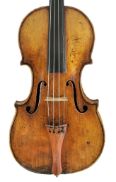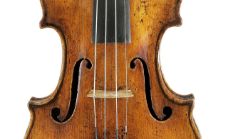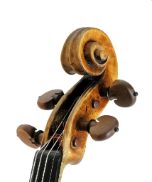Violin, Antonio Stradivari, Cremona, 1718, “ex Viotti-ex Arnold Rosé”
Printed label: “Antonius Stradiuarius Cremonensis / Faciebat Anno 1718” (718 handwritten)As the original printed label indicates, Stradivari made this violin during his Golden Period. It is named after two prominent previous owners. Its body is built on a large, wide model, possibly on the “P” inner mold dated February 25, 1705 (Museo del Violino, Cremona, inventory no. MS 44). The belly has very high arching, whereas the back arching is much flatter. The annual rings of the two-piece belly are medium wide and of very regular grain. Slight growth anomalies can be made out only on the bass side. The two halves of the belly are from the same log, and the most recent annual ring was dated 1698. A dendrochronological analysis established a high degree of correspondence with numerous other violins Stradivari built after 1710. The two-piece maple back is attractively figured with close, regular flames that descend slightly toward the edge. The wood of the ribs is also intensely flamed. The precise edgework is striking, with a very delicate appearance of the black purfle strips. The f-holes are upright, and the upper and lower wings are very narrow. Like all other instruments by Stradivari from this period, this violin has a scroll carved to perfection. Its volutes are regular and perfectly symmetrical. The color varnish with its reddish-brown tints contributes to the instrument’s beauty.
The first verifiable owner of this Stradivari was violinist Giovanni Battista Viotti (1755–1824), born in Piedmont, Italy. Viotti received his musical training in Turin, where he became a member of the court orchestra in 1775. Concert tours took Viotti to destinations as far away as St. Petersburg from 1780. From 1782, he lived in Paris. Today, he is considered the founding father of the French violin school. Viotti recognized the high sound quality of the violins from Cremona. His name is linked to a violin by Giuseppe Guarneri del Gesù and no fewer than nine Stradivari violins, among them the instrument crafted in 1718. The second name given to the violin is that of violinist Arnold Rosé, who owned the Stradivari from 1913. Born as Arnold Josef Rosenblum in Jassy (also Iaşi, located in the historical region of Moldavia in Romania), Rosé studied under Karl Heißler at the Vienna Conservatory. He made his debut as a soloist with the Leipzig Gewandhaus Orchestra in 1879. From 1881, he was the concertmaster and leader of the orchestra at the Vienna Imperial and Royal Court Opera and thus also of the Vienna Philharmonic. With brief interruptions, Rosé held this position until 1938 and shaped the sound of this orchestra like no other concertmaster before him. Immediately after Austria’s annexation by the German Reich, Rosé fled to London in 1938, where he was involved in the Austrian Academy and where he performed with the string quartet he had founded. After his death in 1946, the violin was sold to Louis E. Brooks by New York dealer Emil Herrmann.






